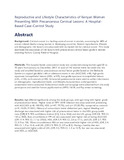| dc.description.abstract | Background: Cervical cancer is a leading cause of cancer in women, accounting for 68% of cancer-related deaths among women in developing countries. Several reproductive, lifestyle and demographic risk factors are associated with increased risk for cervical cancer. This study examined the association of risk factors with precancerous cervical lesion grade in women attending Nakuru County Referral Hospital.
Methods: This hospital-based, case-control study was conducted among women aged 20 to 70 years from January to December, 2017. A total of 142 women were recruited into the study and stratified based on precancerous cervical lesion grades based on the Bethesda System as: atypical glandular cells or adenocarcinoma in situ (AGC/AIS, n=8), high-grade squamous intraepithelial lesions (HSIL, n=59), low-grade squamous intraepithelial lesions (LSIL, n=35), and controls (n=40). Structured questionnaires were used to collect information on demographic, reproductive health, and lifestyle characteristics; anthropometric assessments were conducted. Endocervical swabs and scrapings were obtained from the study participants and used for human papillomavirus (HPV)-16/18, and Pap smear screening.
Results: Age differed significantly among the study groups, with age rising with higher grade of precancerous lesion. Higher rates of HPV 16/18 infection was associated with presenting with AGC/AIS (n=8, 100.0%), HSIL (n=47, 79.7%), and (n= 29, 82.9%), compared to controls (n=4, 10.0%; P<.001). History of concomitant lower abdominal pain, vaginal bleeding and discharge was associated with higher risk of precancerous lesion in the HSIL group (odds ratio [OR] 8.9; 95% confidence interval [CI], 2.6 to 30.6) and the LSIL group (OR 5.8; 95% CI, 1.8 to 18.8). Bust circumference <99 cm was associated with higher risk of having AGC/AIS (OR 17.4; 95% CI, 1.1 to 276.0), HSIL (OR 5.9; 95% CI, 2.0 to 17.1), and LSIL (OR 2.7; 95% CI, 0.9 to 7.8). Waist circumference <86 cm was associated with higher risk of HSIL (OR, 5.4; 95% CI, 1.9 to 15.4) and LSIL (OR 2.9; 95% CI, 0.9 to 8.2). Having a healthy diet was associated with higher odds of LSIL (OR, 4.2; 95% CI, 1.4 to 12.9), but was not associated with HSIL or AGC/AIS.
Conclusion: This study suggests that high-risk HPV 16/18 infection, chronic lower abdominal pain with vaginal bleeding, and decreased upper and lower trunk body mass, are associated with higher risk of precancerous cervical lesions. Integrating targeted cervical cancer screening in routine reproductive health-care services may reduce the risk of developing cervical cancer. | en_US |

